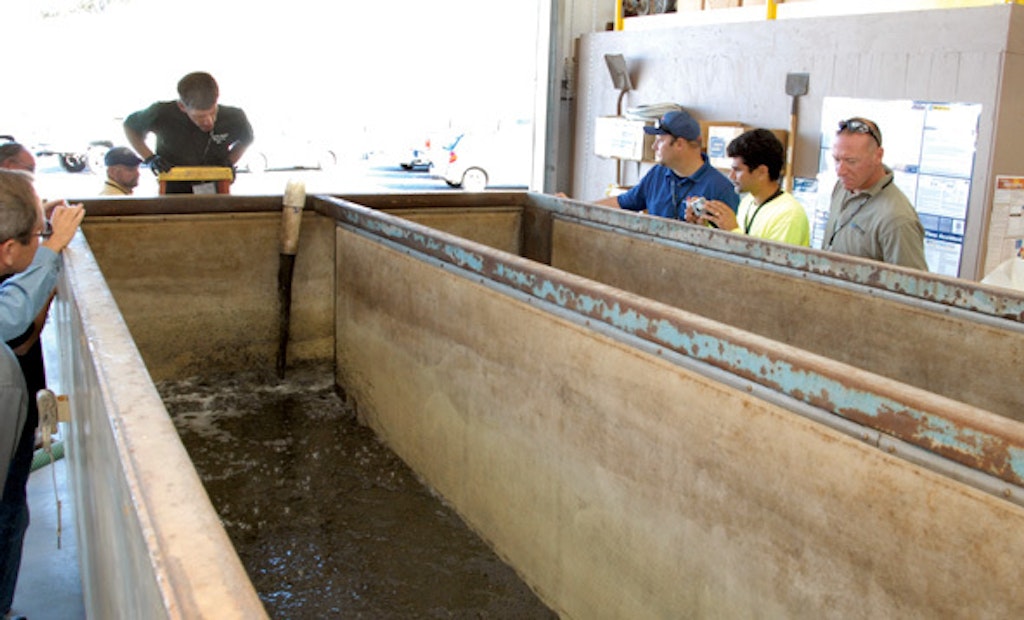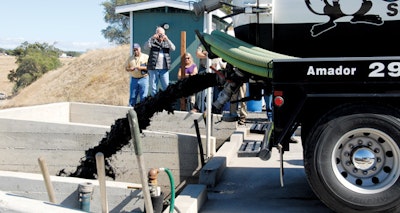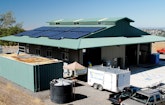
Interested in Dewatering?
Get Dewatering articles, news and videos right in your inbox! Sign up now.
Dewatering + Get AlertsDean Trevaskis remembers a fateful call he got from the county that threatened the future of his pumping business, Sweet Pea Septic Services, located in the foothills of the Sierra Nevada Mountains in Northern California.
“Your disposal site is closed. You’ll have to figure out something else to do,’’ Trevaskis said, repeating the blunt message. He hauled loads of septage three hours one way to find a receptive facility, but that treatment plant raised fees regularly already, making it clear they didn’t want to take his waste.
“I talked to the three counties where we worked and asked them if they were interested in building a local facility. They said ‘no’ and suggested that I might want to look at that myself,’’ Trevaskis said.
ALL’S WELL THAT ENDS WELL
In 1999, necessity drove Trevaskis to open a private processing plant within eyeshot from Sutter Creek in the state’s gold mining and wine country. Today, his upgraded plant – built into the side of a hill – has intelligent design putting gravity to use to move sludge through the treatment train. It’s also powered almost exclusively by a rooftop solar array, keeping operating costs to a minimum.
Trevaskis opened his processing business, Sierra Septic Services, for a tour in October as part of the joint California Onsite Wastewater Association/National Association of Wastewater Transporters Education Forum and Technology Exhibit held in Jackson, Calif. Following a Septage/Grease Waste Treatment Workshop given by NAWT, participants spent
an afternoon following a load of septic waste through the entire Sierra Septic treatment process.
After 12 years in operation, the plant built to keep Trevaskis’ four trucks pumping residential septic and commercial grease trap waste now processes 300,000 gallons monthly in serving his business and three other area pumpers. The plant turns a profit, and Trevaskis sees a lot of potential for growth and may one day move away from pumping and concentrate solely on the processing business.
The pumper said he was excited to share what he’s learned in developing the plant in hopes that it helps others in the industry who are threatened with having no place to turn with their own loads, whether it’s due to diminishing capacity at local plants or starkly rising costs, or both.
“People helped me a lot when I went into this. I learned from other people’s mistakes instead of having to make them myself,’’ Trevaskis said during the California workshop. “So I don’t have a problem sharing what we’ve learned with others.’’
HOW IT WORKS
Sierra Septic is built on a 2.5-acre property with a steep grade that was the resting spot of gold-mining tailings. Trevaskis’ first step was to excavate two terraces in the hill, the lower flat area for the treatment plant and the higher area for a septage receiving facility. He started the tour by taking 50 to 75 visitors up the grade to watch a load of septage being dumped into one of several 5,000-gallon concrete pits elevated about 15 feet above the plant.
Gravity first moves the waste through piping into twin 40,000-gallon rubber-lined metal holding tanks, both recycled industrial tanks – one from a brewery and one an ice-storage tank. From the holding tanks, the sludge continues downhill into the plant, where a stainless steel roto-strainer removes trash and deposits it in bags recycled from another part of the process. When full, the bags are hauled to a landfill with cake produced from dewatering.
The strained wastewater is piped first to a 2,000-gallon grit tank, then into a 20,000-gallon underground holding tank (a recycled gasoline storage tank), where it is constantly churned to prevent settling, then sent on through the process by a pair of Vaughan chopper pumps from Rockwell Engineering. The pumps are equipped with cutter blades and adjustable recirculating nozzles to ensure optimal mixing.
The chopper pumps are the only pumps in the entire process, as they push the sludge into polymer mixing tanks, where plant manager Bob Hess typically mixes one part polymer to 10 parts wastewater. The blended wastewater is sent to either a 20,000-gallon dewatering box from Consolidated Fabricators or a 6-foot diameter by 9-foot-long Alar Engineering Corp. vacuum drum machine. When the dewatering box is used, it takes 6-8 hours to fill the box and about 24 hours to drain the cake to 20-percent solids mix.
The drum machine is usually used to process more waste. A second 30,000-gallon Consolidated Fabricators box kept outside is used as a backup for periods of heavy flow.
To coat the Alar drum, an elevated baghouse is used to mix water with diatomaceous earth, with the slurry pushed through a screw conveyor into a 2,000-gallon plastic tank of water for further blending. The mix flows to the drum, where it is coated to 2 to 2 1/2 inches, at which point the wastewater is picked up by the drum, dried to 40-percent solids and knifed off onto a conveyor belt. The dried cake drops into interchangeable 20-yard rolloff containers that are switched when filled.
The cake is trucked once or twice a week to a landfill about an hour away. The filtered water is sent to an aerated 30,000-gallon tank and treated with a BOD reduction additive from Probiotic Solutions. The treated water typically has about 30 parts per million TSS and less than 400 parts per million BOD. The clear water is released at a slow rate – usually overnight – into Sutter Creek’s sewer system.
USING THE SUN
Early on, Trevaskis decided solar power would be a good way to offset his electric bill for the plant. Installing a 14 kw solar array on the south-facing roof of the metal building and with 300 days a year of California sun, he has been able to wipe out a $1,200-per-month power bill. At times the plant creates more energy than it uses, which the Pacific Gas & Electric utility banks for future use at the plant. A law is also in the works to require the utility to pay customers cash back for the excess solar power they generate, he said.
With generous rebates from government and utility sources, the solar array cost about $140,000 and Trevaskis expects it to be paid off in seven or eight years based on power savings. While he said the payback might not be as fast for pumpers in other regions, solar makes sense in his part of California. And just like he expects municipal treatment plant disposal fees to increase in the future, Trevaskis sees more savings as electric rates rise.
GO FIGURE
The expert advice to most pumpers considering starting their own treatment plants is that they need to be able to lower per-gallon disposal costs significantly before making the investment. A major cost savings was not the biggest factor for Trevaskis, who said he needed to process his own waste because nobody else would. He hasn’t calculated his actual cost of disposal, but Trevaskis said self-reliance and avoiding high transport costs made his plant a smart move.
What advice does he give others considering treating their own waste?
“I wouldn’t look at your needs for today. I’d look at down the road. Where do you propose to be in 10 years?’’ he said. “We could have built smaller. We’re running at about one-third capacity. But you can’t just add on to these machines. It’s not that simple. It’s expensive to go back and retrofit.’’
While it was a clear-cut decision for Trevaskis, he said contractors who already pay a reasonable disposal fee and have short dumping commutes should proceed cautiously with plans for a treatment plant. “If you’re not going to make money at it, I wouldn’t do it,’’ he said.
An advantage of building bigger is that it leaves Trevaskis with a lot of room to grow the business, which could be key if disposal options continue to tighten across his part of the state. He currently serves three pumpers, who pay 17 cents per gallon to treat both septage and grease, and they represent a very small percentage of his revenue. But he’s banking on the demand for his processing services growing, and he’s contemplating maybe concentrating only on the processing end eventually.
“One man operates it, and once it’s established and up and running, it’s a fairly simple operation,’’ he said. “As opposed to pumping, installation and repair business, which is more labor intensive.’’








